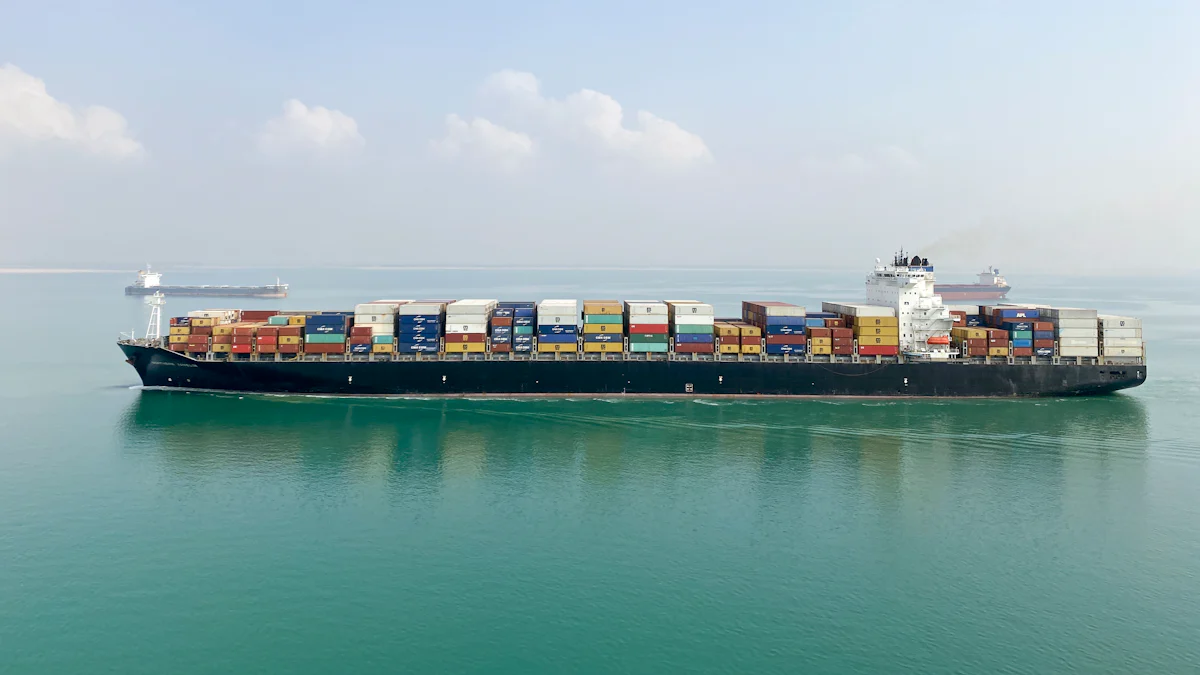Challenges Facing Japan's Traditional Supply Chains

Japan's traditional supply chain plays a crucial role in its economy, deeply rooted in historical practices and relationships. These supply chains, however, face significant challenges today. Japan's reliance on imports, particularly from China, for electrical products and auto parts, makes it vulnerable to disruptions. Natural disasters like earthquakes further threaten supply chain stability. The Japanese government encourages domestic production and technological advancements to enhance resilience. Despite these efforts, the traditional supply chain in Japan struggles to adapt to modern demands, highlighting the need for strategic changes.
Overview of Japan's Traditional Supply Chains
Historical Context
Development of Supply Chains in Japan
Japan's traditional supply chain has evolved over centuries, deeply influenced by its unique cultural and economic landscape. Initially, these supply chains relied heavily on local resources and craftsmanship. The Edo period marked a significant shift, as trade routes expanded and merchants began to play a crucial role in the economy. This era laid the groundwork for the intricate networks that characterize the traditional supply chain in Japan today.
Historical Examples:
During the Meiji Restoration, Japan rapidly industrialized, integrating Western technologies and practices into its supply chains.
The post-World War II period saw Japan emerge as a global economic power, with its supply chains becoming more sophisticated and efficient.
Key Characteristics of Traditional Supply Chains
The traditional supply chain in Japan is known for its emphasis on quality, precision, and long-term relationships. Companies often prioritize trust and loyalty, fostering close ties with suppliers and partners. This approach ensures consistency and reliability, which are hallmarks of Japanese products. However, this same rigidity can hinder adaptability in the face of modern challenges.
Key Characteristics:
Strong focus on quality control and precision.
Long-standing relationships with suppliers.
Emphasis on trust and loyalty.
Current Structure
Major Players and Stakeholders
The traditional supply chain in Japan involves a diverse array of players, from small family-owned businesses to large multinational corporations. Major stakeholders include manufacturers, suppliers, distributors, and retailers. Each plays a vital role in maintaining the flow of goods and services across the country.
Notable Players:
Toyota and Sony are examples of companies that have mastered the art of supply chain management, setting benchmarks for efficiency and innovation.
Small and medium-sized enterprises (SMEs) contribute significantly to the supply chain, often providing specialized components and services.
Typical Processes and Practices
Processes within the traditional supply chain in Japan are characterized by meticulous planning and execution. Companies often employ just-in-time (JIT) inventory systems to minimize waste and enhance efficiency. This method requires precise coordination and communication among all stakeholders.
Typical Practices:
Just-in-time inventory management.
Kaizen, or continuous improvement, to enhance processes.
Integration of automation and robotics to ensure operational continuity during disruptions.
Japan's traditional supply chain faces the challenge of balancing these established practices with the need for innovation. Companies are increasingly adopting innovative strategies to enhance resilience, such as integrating digital tools and forming strategic partnerships. This shift reflects a broader trend towards building supply chains that can withstand both current and future uncertainties.
Key Challenges in the Traditional Supply Chain in Japan

Technological Advancements
Impact of Digitalization
Digitalization significantly impacts the traditional supply chain in Japan. Companies increasingly adopt digital tools to enhance efficiency and streamline operations. Automation and robotics play a pivotal role in this transformation. They reduce reliance on human labor and ensure continuity during disruptions. Technological Innovations and Resilience in Japan's Supply Chains highlights Japan's leadership in integrating automation within supply chains. This integration boosts productivity and minimizes operational delays.
Despite the benefits of digitalization, resistance to change remains a significant hurdle. Many stakeholders in the traditional supply chain in Japan prefer established methods. They value long-standing relationships and trust over new technologies. This reluctance to embrace change hinders the adoption of innovative practices. Companies must address this resistance to remain competitive in a rapidly evolving global market.
Despite the benefits of digitalization, resistance to change remains a significant hurdle. Many stakeholders in the traditional supply chain in Japan prefer established methods. They value long-standing relationships and trust over new technologies. This reluctance to embrace change hinders the adoption of innovative practices. Companies must address this resistance to remain competitive in a rapidly evolving global market.
Globalization and Competition
Pressure from International Markets
Globalization introduces intense competition to the traditional supply chain in Japan. International markets demand speed, efficiency, and flexibility. Japanese companies face pressure to meet these demands while maintaining their reputation for quality. Geographical Diversification and Innovation in Supply Chains suggests that diversified supply chains are more innovative. Japan must diversify its supply chains to enhance competitiveness and adapt to global market conditions.
Adaptation to Global Standards
Adapting to global standards presents another challenge for the traditional supply chain in Japan. International markets often require compliance with specific regulations and standards. Japanese companies must align their practices with these requirements to succeed globally. This adaptation involves strategic changes in product design and supply chain management. Rethinking Traditional Approaches for Building Resilient Supply Chains in Japan emphasizes the importance of flexible product design. Such flexibility enables businesses to adapt to changing market conditions without significant delays.
Environmental and Regulatory Pressures
Sustainability Concerns
Sustainability concerns increasingly influence the traditional supply chain in Japan. Companies must address environmental issues to meet consumer expectations and regulatory requirements. This involves adopting sustainable practices and reducing carbon footprints. The focus on sustainability drives innovation and enhances the resilience of supply chains.
Compliance with Regulations
Compliance with regulations poses a significant challenge for the traditional supply chain in Japan. Companies must navigate complex regulatory landscapes to ensure smooth operations. This involves adhering to environmental, safety, and quality standards. Streamlining compliance processes can enhance efficiency and reduce operational costs. Technological Capacity and Supply Chain Robustness in Japan highlights the role of innovation in building robust supply chains. By boosting technological capacity, Japan can develop replacements in case of supply disruptions.
Potential Solutions and Adaptations
Embracing Technology
Integration of Digital Tools
Japan's traditional supply chain can benefit significantly from integrating digital tools. Automation and robotics enhance production efficiency and reduce reliance on human labor. This technological shift aligns with Japan's focus on ensuring operational continuity during disruptions. By adopting these innovations, companies can streamline processes and improve overall productivity. The use of digital tools also allows for better data management, enabling businesses to make informed decisions quickly.
Training and Development
Training and development play a crucial role in the successful adoption of technology within the traditional supply chain in Japan. Companies must invest in educating their workforce about new technologies and practices. This investment ensures that employees can effectively utilize digital tools and contribute to the company's growth. Training programs should focus on building skills in automation, data analysis, and digital communication. By empowering employees with the necessary knowledge, businesses can foster a culture of innovation and adaptability.
Strategic Partnerships
Collaborations with Global Firms
Collaborating with global firms offers numerous advantages for the traditional supply chain in Japan. These partnerships provide access to international markets and advanced technologies. By working with global companies, Japanese businesses can learn from best practices and enhance their competitiveness. Such collaborations also facilitate the exchange of ideas and resources, leading to innovative solutions for supply chain challenges.
Leveraging Local Expertise
Leveraging local expertise is equally important for strengthening the traditional supply chain in Japan. Local businesses possess valuable insights into regional markets and consumer preferences. By partnering with these enterprises, larger companies can tailor their products and services to meet local demands. This approach not only enhances customer satisfaction but also supports the growth of small and medium-sized enterprises (SMEs) within the supply chain.
Policy and Regulatory Adjustments
Government Support and Incentives
Government support and incentives play a vital role in transforming the traditional supply chain in Japan. Policymakers can encourage innovation by providing financial assistance and tax benefits to companies investing in technology and sustainability. These incentives motivate businesses to adopt new practices and enhance their resilience. Additionally, government initiatives can promote research and development, leading to breakthroughs in supply chain management.
Streamlining Compliance Processes
Streamlining compliance processes is essential for improving efficiency within the traditional supply chain in Japan. Companies often face complex regulatory landscapes that hinder smooth operations. By simplifying these processes, businesses can reduce operational costs and focus on core activities. Policymakers should work towards creating a more transparent and straightforward regulatory environment. This effort will enable companies to comply with standards more easily and enhance their competitiveness in global markets.
Japan's traditional supply chains face numerous challenges, including technological resistance, globalization pressures, and environmental regulations. These issues threaten the stability and efficiency of supply chains, impacting Japan's economic growth. Addressing these challenges is crucial for future prosperity.
Innovation: Companies must embrace innovation to enhance resilience and competitiveness. By focusing on people, processes, and technology, they can future-proof their supply chains.
Sustainability: Sustainable practices are essential for meeting regulatory requirements and consumer expectations.
"Promoting innovation is the key to making Japanese industries more internationally competitive and resilient."
Stakeholders must act decisively to innovate and adapt, ensuring Japan's supply chains remain robust and effective in a rapidly changing world.
See Also
Addressing Globalized World Challenges in Supply Chain Expansion
Exploring Global Consumer Demands with Jusda Supply Chains
Optimizing High-Tech Manufacturing Supply Chain Solutions
